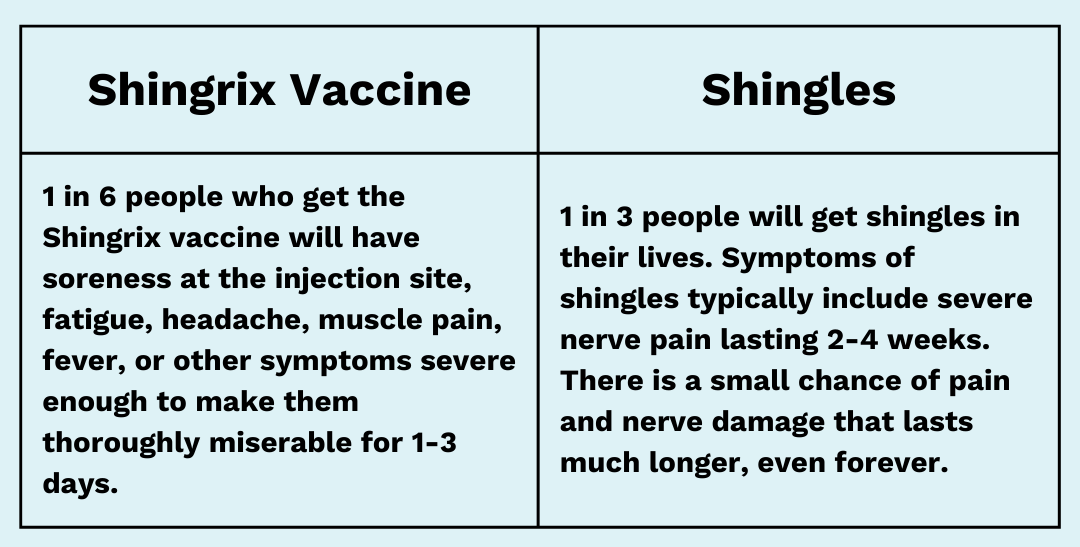4 in 5 people get a sore arm, and 1 in 6 people has a reaction severe enough to send them to bed–like headache, fatigue, muscle pain, or fever. Side effects usually last 1-3 days.
[Note that for the rest of this post, we’ll be talking about Shingrix, the shingles vaccine available in the U.S. to adults age 50 and up and immunocompromised people. It’s given in two doses, 2 to 6 months apart.]
Mild side effects from Shingrix are common. Nearly 4 in 5 people who get the Shingrix vaccine experience some soreness, redness, or swelling at the injection site. Mild headaches and fatigue are also very common, affecting around half of vaccine recipients.
Side effects bad enough to disrupt normal activities affect 1 in 6 Shingrix recipients. When study participants report side effects, they also grade their severity according to whether the symptom kept them from doing their usual activities.
Across several trials including tens of thousands of people, 1 in 6 Shingrix recipients reported side effects that were bad enough to keep them from their usual activities. They include injection-site reactions like pain and swelling and systemic reactions such as headaches, tiredness, fever, shivering, and nausea. The most common among these more severe side effects are headaches and tiredness.
Side effects usually start within 24 hours of the injection and last 1-3 days.
Side effects are inconsistent from dose to dose. Someone who reacts to the first dose might or might not have any reaction to the second dose, and vice versa. So, even if you react to the first dose, get the second one. You may have no reaction at all, and the second dose brings your immunity up quite a bit.
Plan ahead to manage side effects. Given the frequency of side effects, it’s a good idea to plan on taking it easy after your vaccine. If you do have soreness, headache, fever, or other side effects, you can take over-the-counter pain medication like acetaminophen or ibuprofen. Ice packs are a good option for a sore arm.
Rest up, and you’ll be back to your normal superhero self (now with enhanced immunity) in a couple of days.
So, is it worth it? Shingles is extremely common. 1 in 3 people will get it at some point in their lifetime. It is often more severe in older people, but younger people can get shingles too.
In a typical case, shingles causes a blistering rash accompanied by pain, often severe. Other symptoms include itching, fever, headache, sensitivity to light, and tiredness. Symptoms take 2-5 weeks to resolve. For an unlucky few, the infection can damage the nerves and cause continuous, chronic pain for months, years, or even for life. It can also cause blindness if it occurs in the nerves of the eyes.
More than half of working adults who get shingles lose time from work, and the average time lost is 9 days.
Two doses of Shingrix reduces the chances of getting shingles from 1 in 3 to about 1 in 60.
___________________________
Like with many vaccines, we’re asked to choose between something unpleasant that could happen in the near future (like side effects from a vaccine) and something unpleasant that could happen someday (like getting shingles).
The thing is, these risks aren’t equal. Getting shingles is actually more likely and symptoms are much more severe than the side effects from Shingrix.
Here’s what these risks look like side-by-side:

Our brains sometimes convince us that we should discount the risk of the disease itself because it’s in some fuzzy far-off future, while the decision to get vaccinated is happening right now.
This is a cognitive bias known as temporal discounting. We tend to go for smaller immediate rewards than hold out for larger rewards that would come to us in the future. Or, in this case, we put more weight on an immediate risk than a future risk–even when the future risk is actually much larger.
So, don’t let your own brain trick you out of protecting yourself against shingles! Shingrix is recommended for people who are at least 50 and younger people who are or will be immunocompromised. It’s available at most pharmacies and is usually covered by insurance.


